Rating index:
Extraordinary (96-100)
Outstanding (93-95)
Very good to Excellent (89-92)
Above average to Good (86-88)
Below Average to Average (80-85)
Avoid (below 80)
More info >
Extraordinary (96-100)
Outstanding (93-95)
Very good to Excellent (89-92)
Above average to Good (86-88)
Below Average to Average (80-85)
Avoid (below 80)
More info >
One of the nice things of having your own website is that there is no chief-editor whose job it is to limit the number of words of your article. If there was one and if I would be forced to pick four dishes to give an impression of the marathon meal at three-star restaurant Azurmendi described below, it would be 'Bloody Mar' - a swig of the sea, 'Duck Royal a l'Orange' - modern techniques meet old world sophistication, 'Kokotxas' - effortlessly striking, and 'Dry Croissant' - refined indulgence. And if I would be forced to describe chef Eneko Atxa in just a few words, I would say: kind, modest, a culinary genius with an eye for beauty. But the purpose of this review is to lead you deep into the world of Azurmendi and Eneko Atxa, all 20-odd steps of the way.
After a 20 minute drive from Bilbao you arrive at the Azurmendi complex, which, apart from a fine dining restaurant with its own vegetable garden, also consists of a vineyard, a winery and a second (more casual) restaurant called Prêt à Porter. At the highest point of the complex you will find Azurmendi. The restaurant is housed in ecologically built premises and the light and spacious dining room with floor to ceiling windows offers spectacular views over the Basque country side.

The restaurant's history is quite short. Azurmendi was opened by executive chef Eneko Atxa (b.1977 in Bilbao) and his business partners/cousins Gorka Izagirre and Saioa Goitia, whose mothers all bear the same name: Azurmendi. Eneko Atxa began his career at the early age of 15, first at the local Leioa School of Catering and Hospitality and later on he trained at some of Spain's most celebrated restaurants, such as Martin Berasategui in Lasarte, Etxebarri in Atxondo and Mugaritz in Errenteria. During these formative years, Atxa also travelled around the world to discover and soak up the gastronomic delights of many different countries. Azurmendi was awarded its first Michelin star in 2006, a second star followed in 2010 and a third in 2012; Eneko Atxa was 35 at the time.
Azurmendi is open for lunch Tuesday till Sunday and for dinner on Saturdays and they offer two multi-course tasting menus. There's the Erroak Menu (10+ courses + appetizers for €135) and there's the Adarrak Menu (13+ courses + appetizers for €160). I had lunch with my husband at Azurmendi on Wednesday 2 April 2014.
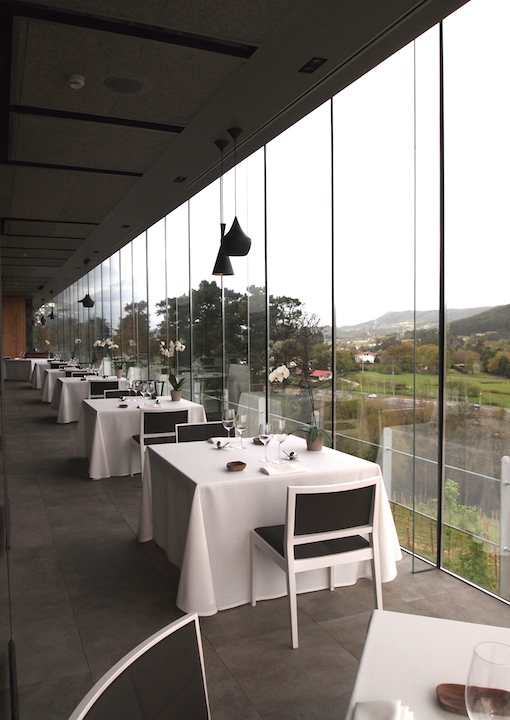
Shortly after we arrived at the restaurant Eneko Atxa's sous-chef Matteo Manzini invited us on a tour through the restaurant's greenhouse, which is located on the first floor of the building, above the kitchen. All guests at Azurmendi are welcomed like this. This tour is also the start of your meal, because hidden between the herbs, flowers and plants is a selection of six appetizers, also known as the 'First Act'.
The first one, presented among the tomato plants, was a Larrabetzu cherry tomato (a local variety). The tomato had been marinated in red fruit vinegar for 3 days, resulting in nice sweet and sour flavours. Next, concealed between some wonderfully fragrant 'flor di alisso' flowers, was a bottle filled with a refreshing, bitter-sweet orange, pomelo and hisbiscus flower juice. Then we stumbled upon a deliciously short, pumpkin and Parmesan, cheese biscuit. This was followed by a creamy and pure guacamole bonbon, disguised as an avocado stone. After that we found a piece oven-roasted Jerusalem artichoke 'bark' stuck to a stem with a lovely concentrated lemon gel and just before we left the greenhouse there was a crunchy baby carrot, that had been marinated in balsamic vinegar for 30 minutes.
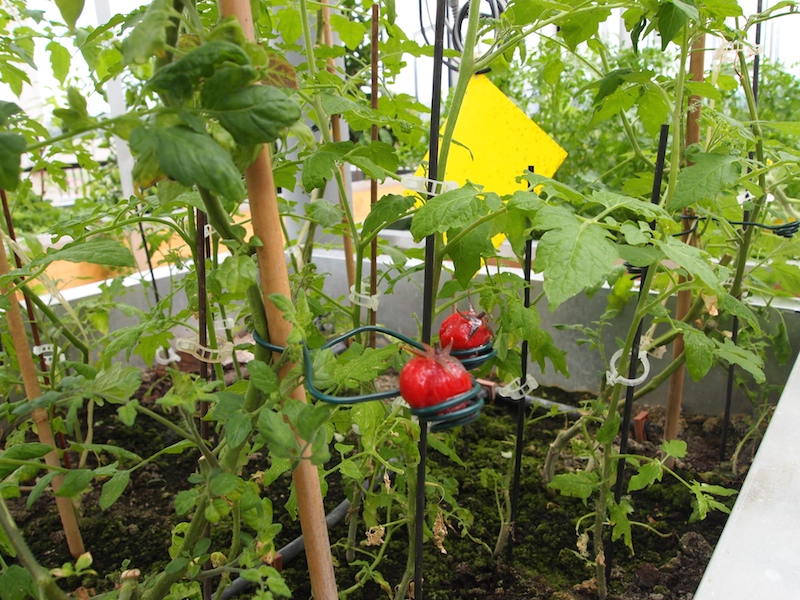
Cherry tomatoes

Orange-pomelo-hisbiscus juice

Pumkin and Parmesan biscuit
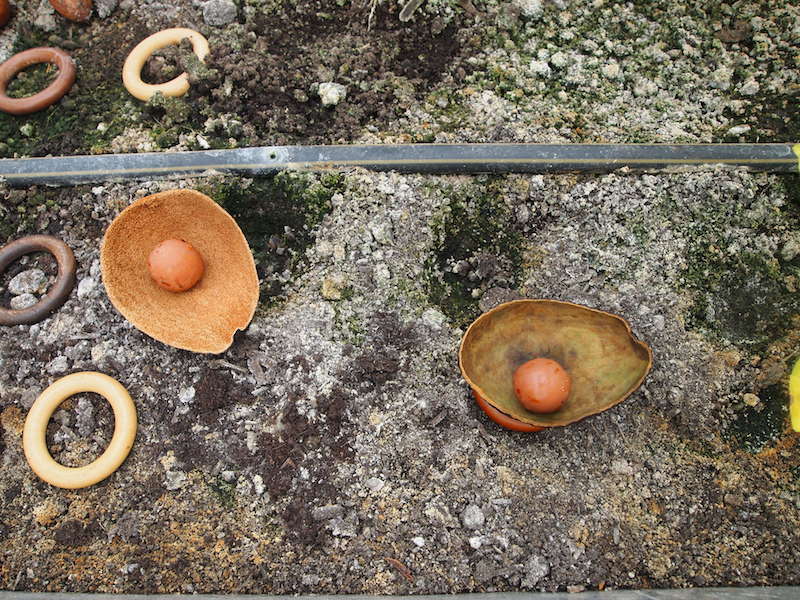
Guacamole bonbon

Jerusalem artichoke 'bark'

Marinated carrot
Back in the grand entrance hall of the restaurant, which also doubles as a beautifully designed indoor garden, we were welcomed by a picnic basket (Second Act), filled with liquid Caipirinha bonbons made with Txakoli instead of rum, bread soufflés covered with a thin slice of transparent Jamón fat and filled with a gorgeous liquid, creamy Jamón filling, and some elegantly salty preserved anchovies.

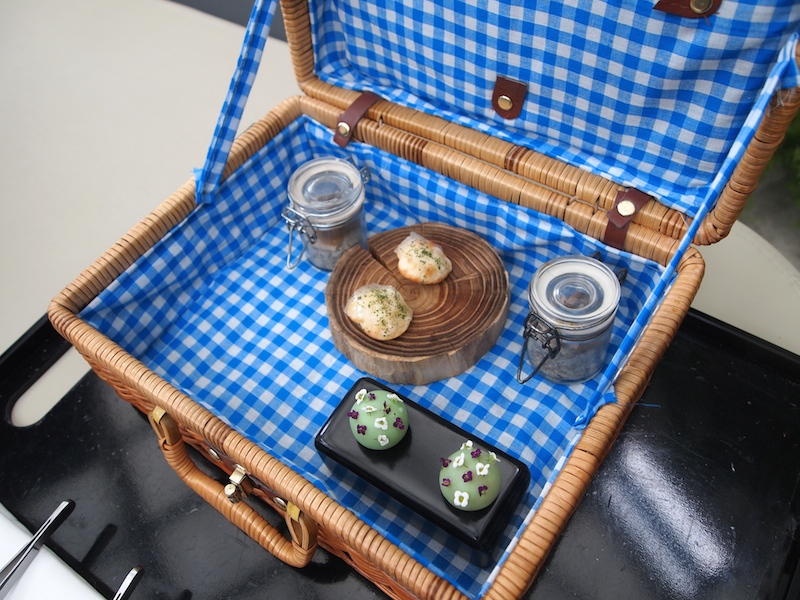
Before the actual meal starts, guests are invited into Azurmendi's spacious and state of the art kitchen. Waiting for us in the kitchen were two more appetizers: black pudding croquetas and a thick and concentrated red bean soup (Third Act). Both were exquisite, the croquetas had a lovely crunchy casing and the soft filling, made from black pudding mixed with vegetables, was delicious; the red bean soup had a great depth of flavour, alsmost like a liquid chilli con carne, but in this case 'sin carne' . Whilst we were enjoying these two appetizers, restaurant manager Jon Eguskiza explained how the kitchen and the restaurant operates. He described the different working stations, the equipment and the reasoning behind the number of chefs working here. He also explained that individual members of front of house (staff) never serve more than two tables.

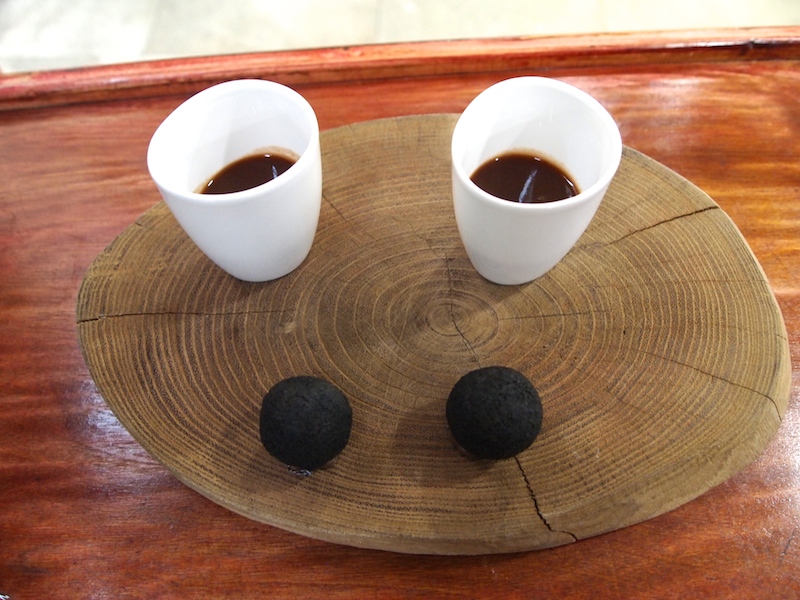
The appetizers served in these first three acts were of exceptional quality, brilliantly original and were certainly an adventurous start of our meal.
Soon after we had been seated at our table, the Fourth Act began. By know it was also time to decide on the menu. Since the restaurant was relatively quiet on the day we were there and we had difficulty in deciding which tasting menu to choose, the restaurant agreed to serve us a blend of both.
First to arrive was a trio of peanut, hazelnut and almond, accompanied by a crunchy 'forest leaf', kissed with the earthy flavour of dried mushroom powder. The peanut, covered with dried mushroom flakes, had a lovely, smooth peanut and foie gras filling. Lovely creamy, mildly grassy notes defined the almond, that had a jellied, slightly bouncy consistency and was made of almond infused milk. The hazelnut had a dark chocolate casing and an elegant duck foie gras filling with a light texture. Three delightful bites delivering a lovely journey on the palate of different nutty, earthy flavours.
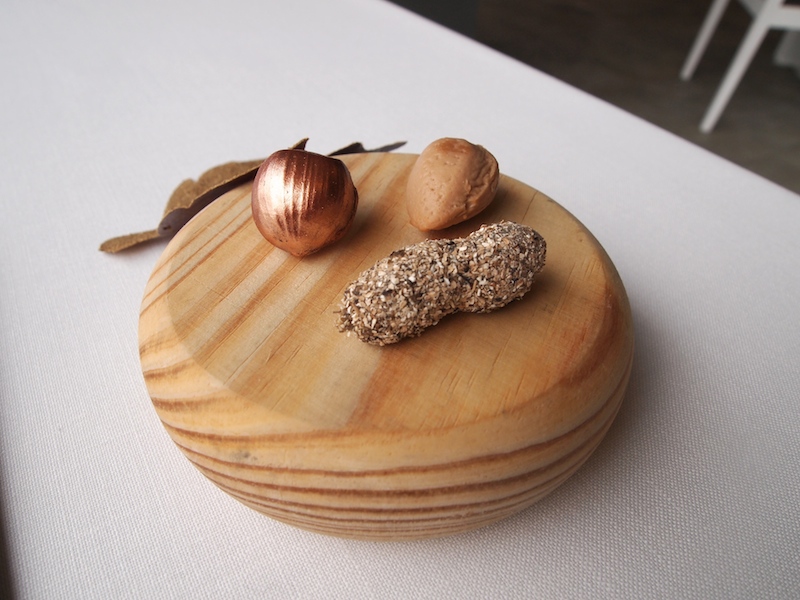
This was followed by one of Azurmendi's signature dishes, truffle infused egg yolk, prepared tableside by Eneko Atxa himself. First some of the yolk is removed from the raw egg yolk with a syringe, then some warm truffle broth is injected into the yolk. Once injected, the warm broth cooks the remaining raw yolk. All this obviously needs to be eaten in one go. Once you bite through the yolk, you first taste the rich yolk which coats your palate, and then there's the earthy, mildly sweet truffle. Beautiful, clean and intense, flavours.
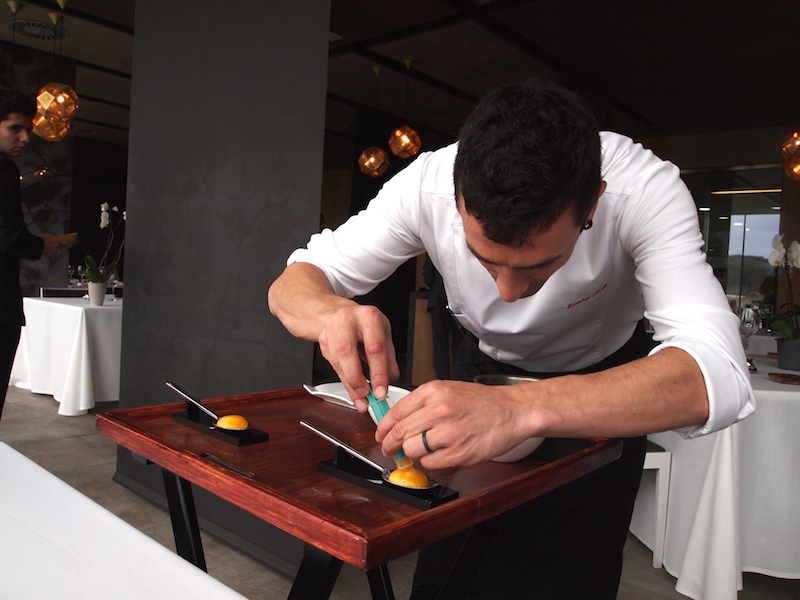
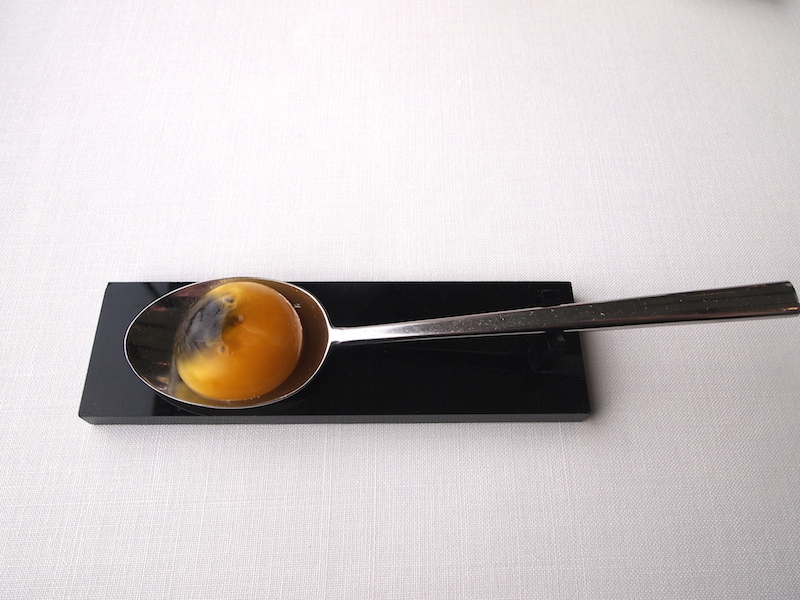
Next was a dish called Bloody 'Mar'. A classic Bloody Mary, flavoured with sea urchin juice, served with some crisp toast topped with a sea urchin cream/mayonnaise, thin slices of celery and finally two dollops of sea urchin roe. The sea urchin juices had transformed the Bloody Mary into a light and delicate drink with a lovely touch of creamy brininess and just the right amount of sharpness. Equally good was the crunchy toast with the ultra-fresh and mildly sweet sea urchin roe that had a nice creamy texture and a hint of nutiness. A sublime combination, with clean, well-defined flavours and a wonderful, long aftertaste.
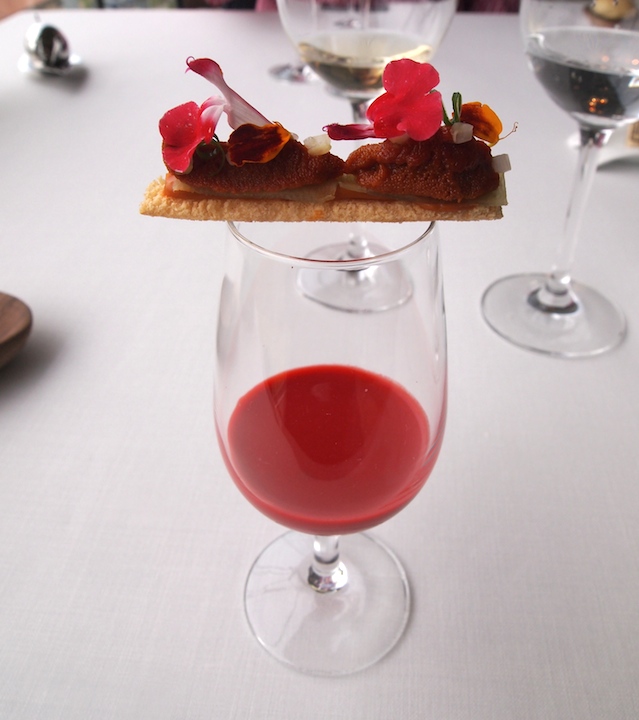
A couple of minutes later a beautifully presented oyster dish arrived. Hidden underneath an elegantly sweet oyster and tomato juice foam, was a spectacularly large and fat Gillardeau oyster (my guess is size 0 - size does matter), cut in half, and placed on top of some oyster mayonnaise. The oyster had been briefly cooked in its shell and this had firmed up the flesh perfectly. With the oyster came some crunchy seaweed tempura (Pistillata and Codium) and an anemone fritter. A very pleasing combination with great contrast of textures.

Then there were two identical spinach tartlets with a filling of skinned cherry tomatoes, Idiazábal (a raw sheep's milk cheese from the Basque country) spheres, tomato puree, crisp tomato skins and deep-fried baby basil leaves, accompanied by some Idiazábal ice cream. Deliciously sweet tomatoes, bursting with natural juices; their sweetness combined wonderfully with the freshness of the Idiazábal cheese spheres, the latter producing an incredible mouthfeel. The flavour marriage of tomatoes and sheep's cheese worked brilliantly in this dish and the ice cream added a nice extra flavour dimension.
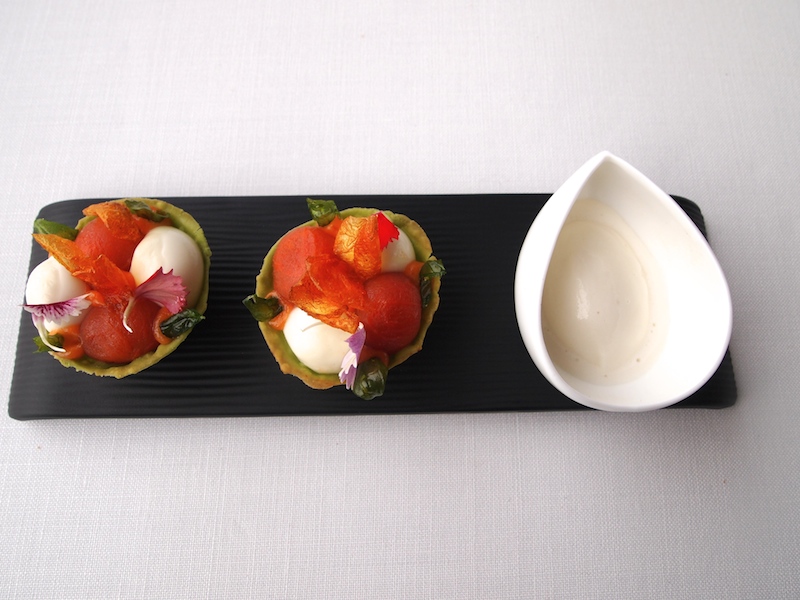
Shortly after there was lobster. Superbly cooked (roasted) lobster, with some lobster roe on top, served with a bright green chive olive oil and a sweet and mildy sharp chive emulsion. Perched on top of the lobster was a thin and crisp herb cornetto, filled with fresh lobster tartare. I loved how the warmth (temperature) of the chive emulsion enhanced the sweetness of the chives, merging happily with the sweet lobster. A cold emulsion would have given a different, less polished, flavour experience. A very clever dish with delicately balanced flavours.

Drum roll. Time for Duck à la Royale. This iconic dish, together with its brother Hare à la Royale, has been making its way back on to the menus of Michelin starred restaurants in Europe and in my experience some versions are better than others. Eneko Atxa's version is a combination of Duck à la Royale and Duck à l'Orange and it was sensational: I just couldn't stop smiling. So, first the Duck a la Royale. I don't know the exact ingredients but this one was a ballotine-shaped mixture of gloriously moist duck meat, truffle and foie gras, covered with a dark and gelatinous duck sauce, almost like a thin jelly. To represent the orange there were a few sprays of orange blossom perfume when the dish was served and on the plate there was some fresh orange, marinated in orange wine, a beautifully made 'orange segment' of duck foie gras mousse covered in a thin orange jelly, and finally some orange zest powder. A fiendishly complex dish that was perfectly executed. The Royale had deliciously intense flavours but (surprisingly) it was not too rich and, most importantly, the duck meat was not too dry.
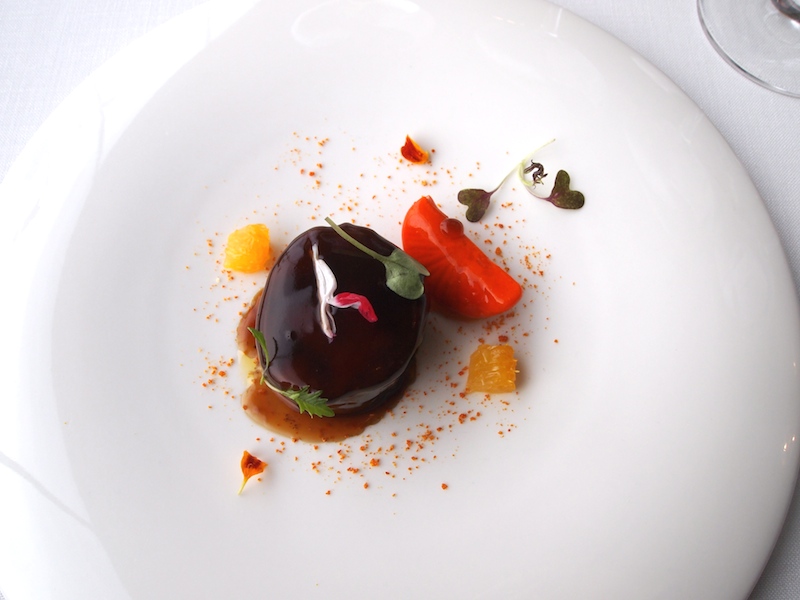
Next on the menu was a dish of squid noodles and pickled onions, complemented by a dark and syrupy squid reduction poured from a teapot. A squid ink puff (made with choux pastry) was served on the side. To make the squid noodles they first make a raw squid 'mille feuille'. The squid is then frozen, and thereafter cut into noodles, which are served at room temperature. A separate squid (roasted with onions) is used to make the squid reduction. The intensity of the squid reduction was fantastic and its warm temperature very gently cooked the squid on the plate, resulting in a beautiful tender texture. A distinctive dish with intense flavours, the pickled onions delivering just the right amount of acidity. Loved the simple, clean presentation.

This was followed by Kokotxas pil-pil, a traditional Basque fish dish. The main ingredients in this dish are hake throats (Kokotxas), olive oil and garlic; "pil-pil" refers to the sound of the gentle bubbles that appear in the olive oil, in which the hake throats are briefly cooked. Kokotxas is not a cheap ingredient at all: it may cost around €60 a kilogram. First the hake throats are cooked in a little olive oil that has been mildly flavoured with garlic. Then, as soon as the throats' gelatin starts melting into the olive, the olive oil is poured into another pan. Then, drop by drop, the oil is added back to the pan with the throats and gelatin and by gently whirling around the mixture in the pan, a terrific pil-pil emulsion is created. This is obviously a delicate balancing act and particularly for the last stage some seriously experienced wrist movement is required. The Kokotxas had the most amazing creamy flavour and a little bit of oceanic freshness right at the end. The garlic flavour in the pil-pil was subtle, but attractive. Also on the plate were two crisp pommes soufflés, that had a delicious sweet and nutty garlic puree filling. A spectactular dish with precise flavours and an impressive display of true craftsmanship.
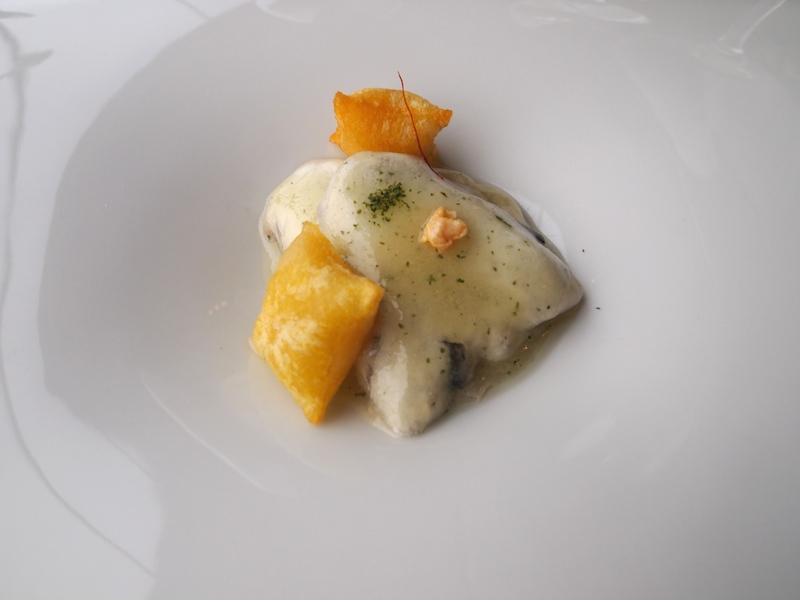
The last fish course was a piece of superbly cooked red mullet, served with cauliflower caviar, cauliflower puree and two small pieces of roasted cauliflower. Hidden underneath the red mullet was some 'Taxangurro', a delicious mixture of spider crab, leek, carrot and tomato. The fattiness of the mullet married well with the cauliflower and the spider crab added a nice flavour contrast. Loved the intensity of the cauliflower puree, but the flavour of the cauliflower caviar was a bit too subtle for my taste.
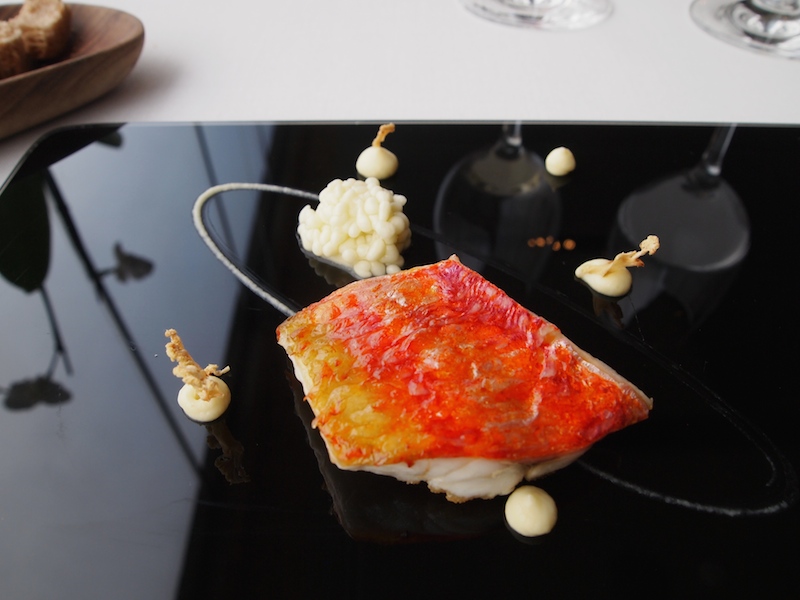
Time for two meat courses. First up was suckling pig. A piece of meltingly soft confit pork (rib), a crisp pig's ear, pork crackling, a pork jus reduction, pumpkin sponge cake and crunchy pumpkin filled with a lightly smoked pumpkin puree. The texture of the confit pork was incredibly gelatinous and the skin was nice and crispy. Equally good was the exquisite pork jus reduction that had a refined depth of flavour. An extremely elegant dish with complex nuances of sweetness from pork and pumpkin.

Next to be served was perfectly cooked dark-red pigeon breast, accompanied by a well-reduced pigeon jus, thinly sliced raw white mushrooms, a nice and buttery mushroom duxelle, dots of concentrated mushroom puree and some freshly shaved black truffle. A salad of sliced raw white mushrooms, truffle and cress was served on the side. The pigeon was sublime, as was the earthy, rich jus, that had a long lingering gaminess. A beautifully balanced dish with a great variety of mushroom flavours and textures, the raw mushrooms in particular adding a lovely freshness that really complemented the rich pigeon.

On to the desserts, four in total. To start there was a feather light and brittle raspberry 'croissant' with a delicious and silky cream cheese filling, flavoured with fresh herbs like thyme and rosemary. A delightful combination of fresh, sweet and herby flavours. The second dessert was comprised of milk ice cream, yoghurt jelly cubes, crisp milk skin and two 'eggs' with a satiny liquid egg flan (crème caramel) filling. A lovely contrast of textures, delicious, subtle milky flavours and a nice, elegant touch of sweetness.
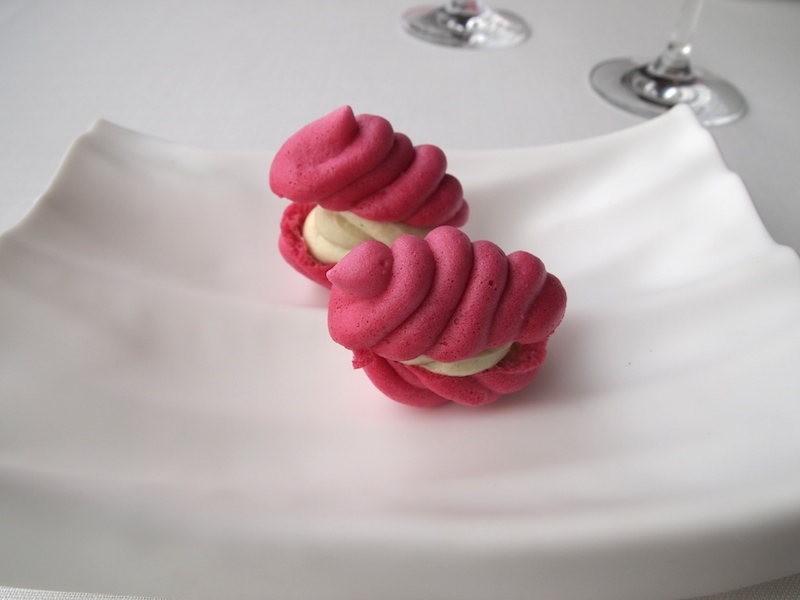

Then there were roasted apple bonbons, accompanied by dots of pure and intense rocket gel, fresh and creamy apple ice cream and some fresh apple, marinated in Txakoli (a Basque dry white wine). A bowl filled with dry ice and mint leaves is placed next to the plate, onto which apple juice is poured, creating a dramatic and aromatic effect. The bonbons were marvellous; after the initial crunch of the bonbon's casing you taste warm and elegantly sweet roasted apple flavours. Subsequently there's the peppery flavours from the colourful rocket puree, making it a good contrast to the roasted apple. The ice cream gave the dish a nice, creamy finish.
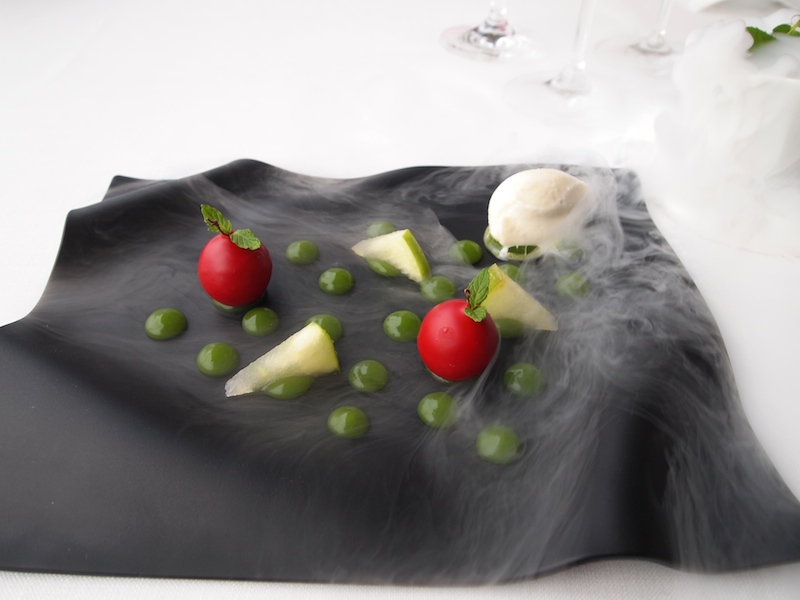
Last dessert was a very pure and clean-tasting cherry ice cream, served with caramel-almond cream, a few sugar 'rocks', fresh raspberries and some candied mint leaves. A refreshing dessert with a wonderful interplay of textures and flavours, the cherry and almond complementing each other perfectly and the silky texture of the caramel-almond cream delivering a touch of creamy luxury; the sugar rocks added a pleasant sweetness.
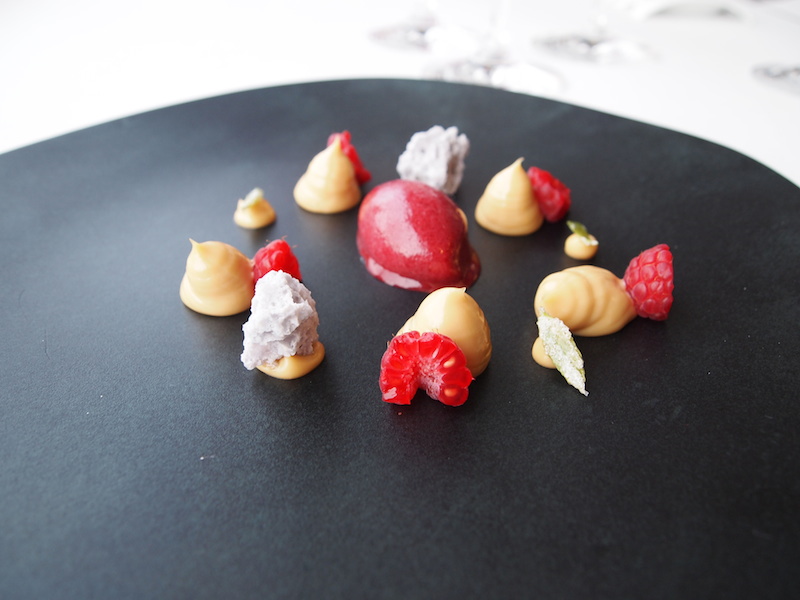
"Great innovation is born from inspiration and from an understanding of tradition and classic innovations of the past", Heston Blumenthal once said and this applies to Eneko Atxa and his cuisine. But what exactly is it that sets Eneko Atxa apart? It is not easy to define the greatness of his cuisine, but for me the essence perhaps lies in a unique balance between creative intuition and immaculate technique. This results in very individual food that is spectacular but not about spectacle, undramatic but dramatically good. There is great purity here, both of intention and of flavour, and this produces emotive dishes where nothing is out of place. There is a certain ease, a certain restraint that seems to originate from his deep affection for local ingredients and traditions. Eneko Atxa plays tradition against innovation and he uses ingredients of amazing quality from which he extracts pure beauty. The profusion of dishes in this marathon meal only serves to underline the originality and creativity of a chef deeply rooted in the Basque soil. Every individual plate of food is superbly focused and executed with supreme precision. Eneko Atxa is one of the great culinary artists of his generation and Azurmendi is his home.













